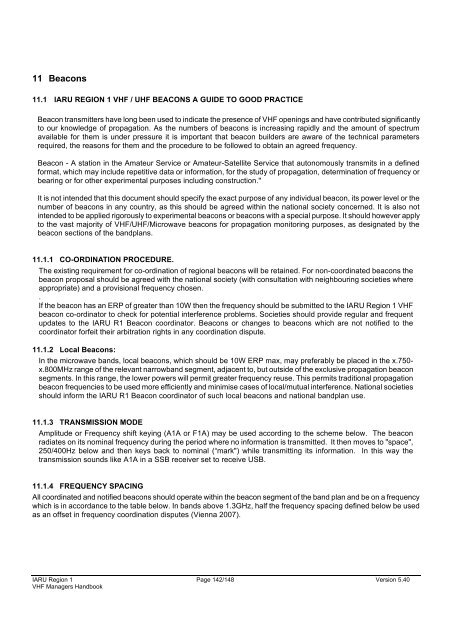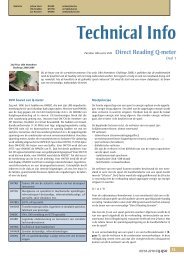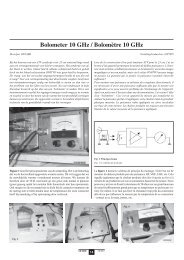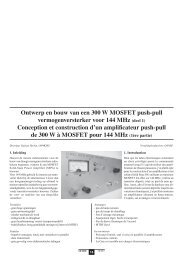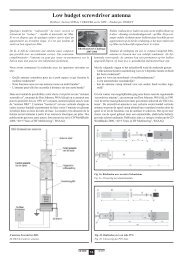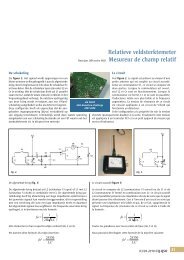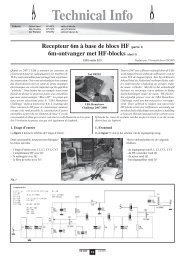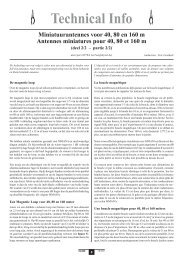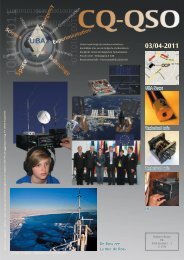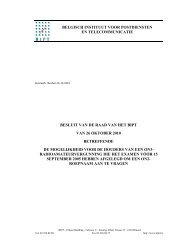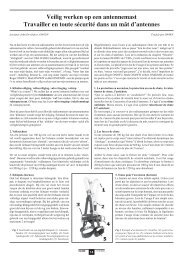IARU Region 1 VHF Managers Handbook - UBA
IARU Region 1 VHF Managers Handbook - UBA
IARU Region 1 VHF Managers Handbook - UBA
Create successful ePaper yourself
Turn your PDF publications into a flip-book with our unique Google optimized e-Paper software.
11 Beacons<br />
11.1 <strong>IARU</strong> REGION 1 <strong>VHF</strong> / UHF BEACONS A GUIDE TO GOOD PRACTICE<br />
Beacon transmitters have long been used to indicate the presence of <strong>VHF</strong> openings and have contributed significantly<br />
to our knowledge of propagation. As the numbers of beacons is increasing rapidly and the amount of spectrum<br />
available for them is under pressure it is important that beacon builders are aware of the technical parameters<br />
required, the reasons for them and the procedure to be followed to obtain an agreed frequency.<br />
Beacon - A station in the Amateur Service or Amateur-Satellite Service that autonomously transmits in a defined<br />
format, which may include repetitive data or information, for the study of propagation, determination of frequency or<br />
bearing or for other experimental purposes including construction."<br />
It is not intended that this document should specify the exact purpose of any individual beacon, its power level or the<br />
number of beacons in any country, as this should be agreed within the national society concerned. It is also not<br />
intended to be applied rigorously to experimental beacons or beacons with a special purpose. It should however apply<br />
to the vast majority of <strong>VHF</strong>/UHF/Microwave beacons for propagation monitoring purposes, as designated by the<br />
beacon sections of the bandplans.<br />
11.1.1 CO-ORDINATION PROCEDURE.<br />
The existing requirement for co-ordination of regional beacons will be retained. For non-coordinated beacons the<br />
beacon proposal should be agreed with the national society (with consultation with neighbouring societies where<br />
appropriate) and a provisional frequency chosen.<br />
.<br />
If the beacon has an ERP of greater than 10W then the frequency should be submitted to the <strong>IARU</strong> <strong>Region</strong> 1 <strong>VHF</strong><br />
beacon co-ordinator to check for potential interference problems. Societies should provide regular and frequent<br />
updates to the <strong>IARU</strong> R1 Beacon coordinator. Beacons or changes to beacons which are not notified to the<br />
coordinator forfeit their arbitration rights in any coordination dispute.<br />
11.1.2 Local Beacons:<br />
In the microwave bands, local beacons, which should be 10W ERP max, may preferably be placed in the x.750x.800MHz<br />
range of the relevant narrowband segment, adjacent to, but outside of the exclusive propagation beacon<br />
segments. In this range, the lower powers will permit greater frequency reuse. This permits traditional propagation<br />
beacon frequencies to be used more efficiently and minimise cases of local/mutual interference. National societies<br />
should inform the <strong>IARU</strong> R1 Beacon coordinator of such local beacons and national bandplan use.<br />
11.1.3 TRANSMISSION MODE<br />
Amplitude or Frequency shift keying (A1A or F1A) may be used according to the scheme below. The beacon<br />
radiates on its nominal frequency during the period where no information is transmitted. It then moves to "space",<br />
250/400Hz below and then keys back to nominal (“mark") while transmitting its information. In this way the<br />
transmission sounds like A1A in a SSB receiver set to receive USB.<br />
11.1.4 FREQUENCY SPACING<br />
All coordinated and notified beacons should operate within the beacon segment of the band plan and be on a frequency<br />
which is in accordance to the table below. In bands above 1.3GHz, half the frequency spacing defined below be used<br />
as an offset in frequency coordination disputes (Vienna 2007).<br />
<strong>IARU</strong> <strong>Region</strong> 1 Page 142/148 Version 5.40<br />
<strong>VHF</strong> <strong>Managers</strong> <strong>Handbook</strong>


